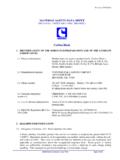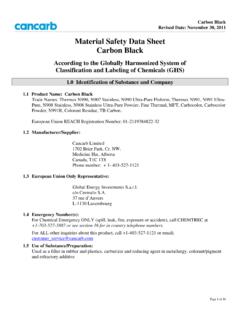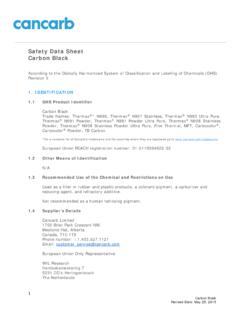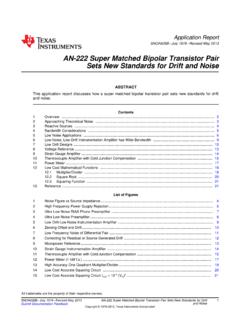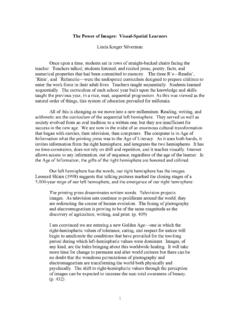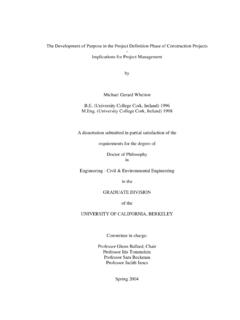Transcription of RUBBER GRADE CARBON BLACKS By: D. T. Norman
1 RUBBER GRADE CARBON BLACKS By: D. T. Norman Manager, Product Development Witco Corporation, Concarb Division Houston, Texas Over the years, many materials have been used as fillers in RUBBER compounds. In this sense, filler is a diluent and is used primarily to lower volume cost. With use, all fillers modify certain physical properties of the compound in addition to lowering cost. Therefore, lower cost is generally achieved at the expense of other desirable properties and all compounds are compromises with various trade-offs considered and balanced by the compounder. Elastomer systems respond to the addition of a few fillers, termed reinforcing agents, in a way that enhances certain properties.
2 Among such substances used in RUBBER compounding, CARBON black is unique in its ability to significantly enhance the properties of nearly any base elastomer system while lowering cost. It is truly more than a simple filler. Buried within the generic term CARBON black are many variations on a theme. There are so many facets to CARBON black , each altering a RUBBER compound in its own subtle way, that the number of possible products is almost limitless. Recognition of some of these facets has, in many instances, been easier than devising corresponding testing methods, which would allow process control and exploitation as new products. Indeed, product refinement in the CARBON black industry is probably hampered more by lack of definitive testing methods than by any other single problem.
3 Still, a vast amount of progress has been achieved by the industry to the point that CARBON black is doubtless the most refined and best-controlled commodity available to the RUBBER industry. Basic Chemistry In the simplest terms, CARBON black is essentially elemental CARBON in the form of extremely fine particles having an amorphous molecular structure. Buried within the amorphous mass is an infrastructure of microcrystalline arrays of condensed rings. These arrays appear to be similar to the layered condensed ring form exhibited by graphite, which is another form of CARBON . The orientation of the arrays within the amorphous mass appears to be random, consequently a large percentage of arrays have open edges of their layer planes at the surface of the particle.
4 Associated with these open edges are large numbers of unsatisfied CARBON bonds providing sites for chemical activity. In use, particles remain largely intact and many of the useful properties of CARBON black stem from their morphological characteristics while others result from surface activity. Other than CARBON , also present are very small quantities of other elements such as oxygen, hydrogen, and sulfur occurring in various functional groups bound to the CARBON mass. In addition, small quantities of condensed hydrocarbons are adsorbed onto the particle surface of most RUBBER GRADE carbons. Extraneous materials originating from the manufacturing process and equipment are typically also found in CARBON black , for example: moisture, refractory dust, metallic oxides, coke, and water soluble salts.
5 The levels of these materials are controlled within specified limits and are usually not significant in the final RUBBER product. The Manufacturing Process CARBON black is a product of incomplete combustion. It is the dark component of smoke and in fact all CARBON black processes start with the production of a "smoke." In the process, the first step is to produce an intensely hot combustion zone with a convenient fuel. After combustion is complete, a hydrocarbon feedstock in excess of stoichiometric quantities is injected into that intensely hot zone. With this injection, CARBON black will be produced, the art comes with assuring that the required properties are attained, the volume adequate and the cost supportable.
6 Following the feedstock injection, the reaction is stopped by either injection of water or by allowing the temperature to decay with time. All furnace grades are made in a continuous process while thermal grades are made in a cyclical process. The CARBON particles thus produced are separated from the process gas stream or "smoke" by conventional means and pelletized to increase the bulk density. Although not all hydrocarbons lend themselves to economical production, essentially any combustible hydrocarbon could theoretically be used as a feedstock to produce CARBON black . Morphology Morphology is a term having to do with the form and structure of an entity.
7 Although not a common word, it certainly has been aptly applied in discussions of CARBON black technology since the properties of CARBON black , to a large extent, depend upon form and structure. Industry Conventions for Particles and Aggregates In the CARBON black industry, the convention has been to refer to the smallest individually distinct unit of CARBON as an aggregate. This convention contrasts with that of other pigment industries in which the smallest distinct unit of material is referred to as a particle. The CARBON black industry convention, however, refers to the component parts of aggregates as particles. The distinctions between particles and aggregates are readily observable with the aid of electron microscopy.
8 Fig. 1, shows a sample of N351 at 150,OOOX magnification; both a particle and an aggregate are labeled. Note that clusters of fused particles make up aggregates. Average particle size and average aggregate configuration play major roles in determining the utility of a given CARBON black GRADE in a RUBBER formulation. In fact, the major differences between grades result from control of these averages, but such averages are difficult to assess with the limited sample size observable with an electron microscope. Fortunately, there are other methods available to quickly assess these fundamental characteristics. Particles The average particle size of commercially available RUBBER type CARBON black grades ranges from about 10 to 500 nanometers.
9 Within this fifty to one spread exists the possibility of a very large number of grades, each providing the RUBBER formulation a unique set of properties. In general, the larger the particle size, the lower the cost and the poorer the reinforcement potential of the material. Just as the average particle size is important so also is the distribution of particle sizes. Distributions of particle size can be narrow or broad or even bimodal, each type influencing the RUBBER properties in its own subtle way. To further confuse the picture, broad distributions may occur, for example, as narrow distributions within single aggregates, but as a broad distribution in the GRADE .
10 Such distributions are easily produced if the products of one or more reactors operated under differing conditions are blended. Yet a different type distribution occurs when a range of particle sizes exists within single aggregates. To date, convenient means of measuring all types of distributions do not exist; however, the manufacturer can exercise a degree of control, as suggested by the example just mentioned, through astute manipulation of various process factors and conditions. Aggregates As is apparent in Fig. 1, individual CARBON black aggregates occur in what appear to be random constructions of randomly sized particles, but when dealing with aggregates, enormous numbers are involved and it is the mean effect of all these individual entities that must be controlled.
